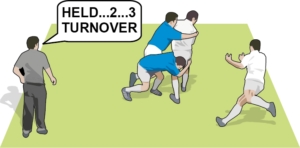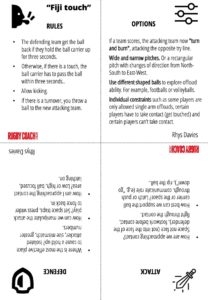You are viewing
1 of your 2 free articles
Adaptive games: A coaching guide to "Fiji touch"
Small-Sided Gamesby Rhys Davies
Don’t just play a game in training, make sense of it for you and your players. London Irish Academy Coach Development Officer, Rhys Davies develops “Fiji touch”.

The defending team get the ball back if they hold the ball carrier up for three seconds.
Otherwise, if there is a touch, the ball carrier has to pass the ball within three seconds.

Alternative rules can be:
Numbers: Ideally 10 v 10
Youngest year group: 13+ although with the younger age groups I would be encouraging them to make sure they are tackling correctly before thinking about trying to hold up the ball carrier.
Ideal parameters: It is more effective on a narrow pitch as there is more opportunity to perform the skill.
In defence, players can explore different ways to turnover the ball. It also encourages defensive decision-making.
If two defenders decide to step in, they leave possible gaps in the defence. A quick pass from an attacker might expose these gaps.
In attack, players can draw in defences and then move the ball away quickly. They also have to keep the ball alive close to or in contact.
Supporting players, both in attack and defence, have to read their teammates movements to exploit gaps or fill in, whilst also understanding the importance of staying square in defence.
Questions to challenge the players
Questions to challenge the players

Examples for skills zones to use when you want to focus on an element of the game. Click on the links for more ideas.
Here are some options to run the session.
Press wider - Press hard on the outside to push attackers back to the traffic (more opportunity to hold the player up)
Low or high in contact - The height that a player goes into contact. Low means driving through, while high allows more chance for an offload.
Space not face - Attack the space either side of the defenders, avoid where possible running directly at the 'face' of the defender.
Fight through contact - Work hard to stay on feet and drive through the area of contact.
Stay square in defence - Don't commit one shoulder to the tackle, keep facing up the pitch and balanced, to move either way.
Width – Can the attacking team stay spread out across the pitch?
Support line – The runner running towards the opposition try line in close proximity to the ball carrier.
Mismatch for speed and pace – Some one with more speed the opposition in front of them. For example, a winger v a prop.
Space traps – The defence showing the attack opportunities (space) to attack, different to what they would normally see to fool them into a false sense of security.
Self-organising – The players, not the coaches, resetting themselves in attack and defence before and during game play.
Here are some examples of other games which help players work on support and continuity.

THE GAME
The defending team get the ball back if they hold the ball carrier up for three seconds.
Otherwise, if there is a touch, the ball carrier has to pass the ball within three seconds.

Alternative rules can be:
- If there is a turnover, you throw a ball to the new attacking team.
- If a team scores, the attacking team now "turn and burn", attacking the opposite try line.
Numbers: Ideally 10 v 10
Youngest year group: 13+ although with the younger age groups I would be encouraging them to make sure they are tackling correctly before thinking about trying to hold up the ball carrier.
Ideal parameters: It is more effective on a narrow pitch as there is more opportunity to perform the skill.
WHY USE IT
In defence, players can explore different ways to turnover the ball. It also encourages defensive decision-making.
If two defenders decide to step in, they leave possible gaps in the defence. A quick pass from an attacker might expose these gaps.
In attack, players can draw in defences and then move the ball away quickly. They also have to keep the ball alive close to or in contact.
Supporting players, both in attack and defence, have to read their teammates movements to exploit gaps or fill in, whilst also understanding the importance of staying square in defence.
TOOLS TO USE
- Wide and narrow pitches. Or a rectangular pitch with changes of direction from North-South to East-West.
- Use different shaped balls to explore offload ability. For example, footballs or volleyballs.
- Individual constraints such as some players are only allowed single arm offloads, certain players have to take contact (get touched) and certain players can't take contact.
ATTACKING FOCUS
Questions to challenge the players
- How are we approaching contact? Space not face (not into the face of the defender), footwork before contact, fight through the contact.
- How best can we support the ball carrier or the space? Latch or push through, communicate role (e.g. "go down"), rip the ball.
DEFENDING FOCUS
Questions to challenge the players
- Where is the most effective place to cause a hold up? Isolated attacker, size mismatch, greater numbers.
- How can we manipulate the attack play? Set space traps, press wider to force back in.
- How am I approaching the contact area? Low or high, ball focused, latching on.

SKILLS ZONES
Examples for skills zones to use when you want to focus on an element of the game. Click on the links for more ideas.
HOW TO RUN THE SESSION
Here are some options to run the session.
- Whole-part-whole: Start with the game, break out into some skills zones, then return to the game.
- Game constraints (low load), game constraints (medium load). Start with the game, but with two-player touch rules. Underload or overload the attack or defence, maybe even reward a team with an extra player if they manage to hold up a player.
- This week, next week, the week after: Play the game this week for a short amount of time, say 10 minutes. Return to it next week, then return to it three weeks after that. Each time you repeat the game, ask the players before they start, what they would do different. This layers their tactical appreciation.
JARGON BUSTERS
Press wider - Press hard on the outside to push attackers back to the traffic (more opportunity to hold the player up)
Low or high in contact - The height that a player goes into contact. Low means driving through, while high allows more chance for an offload.
Space not face - Attack the space either side of the defenders, avoid where possible running directly at the 'face' of the defender.
Fight through contact - Work hard to stay on feet and drive through the area of contact.
Stay square in defence - Don't commit one shoulder to the tackle, keep facing up the pitch and balanced, to move either way.
Width – Can the attacking team stay spread out across the pitch?
Support line – The runner running towards the opposition try line in close proximity to the ball carrier.
Mismatch for speed and pace – Some one with more speed the opposition in front of them. For example, a winger v a prop.
Space traps – The defence showing the attack opportunities (space) to attack, different to what they would normally see to fool them into a false sense of security.
Self-organising – The players, not the coaches, resetting themselves in attack and defence before and during game play.
Here are some examples of other games which help players work on support and continuity.
Newsletter Sign Up
Coaches Testimonials

Gerald Kearney, Downtown Las Vegas Soccer Club

Paul Butler, Florida, USA

Rick Shields, Springboro, USA

Tony Green, Pierrefonds Titans, Quebec, Canada
Subscribe Today
Be a more effective, more successful rugby coach
In a recent survey 89% of subscribers said Rugby Coach Weekly makes them more confident, 91% said Rugby Coach Weekly makes them a more effective coach and 93% said Rugby Coach Weekly makes them more inspired.
Get Weekly Inspiration
All the latest techniques and approaches
Rugby Coach Weekly offers proven and easy to use rugby drills, coaching sessions, practice plans, small-sided games, warm-ups, training tips and advice.
We've been at the cutting edge of rugby coaching since we launched in 2005, creating resources for the grassroots youth coach, following best practice from around the world and insights from the professional game.
More from us
© 2023 Rugby Coach Weekly
Part of Green Star Media Ltd. Company number: 3008779
We use cookies so we can provide you with the best online experience. By continuing to browse this site you are agreeing to our use of cookies. Click on the banner to find out more.














